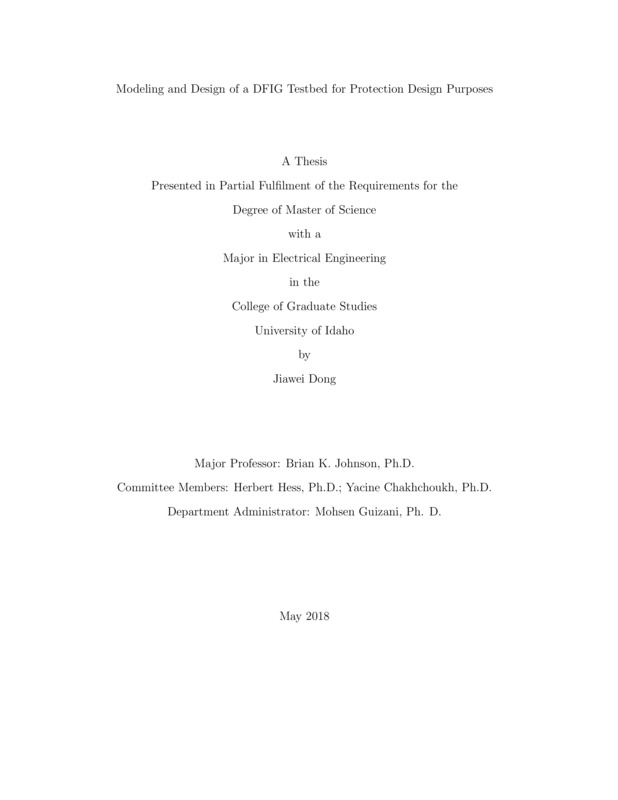Modeling and Design of a DFIG Testbed for Protection Design Purposes
Dong, Jiawei. (2018-05). Modeling and Design of a DFIG Testbed for Protection Design Purposes. Theses and Dissertations Collection, University of Idaho Library Digital Collections. https://www.lib.uidaho.edu/digital/etd/items/dong_idaho_0089n_11369.html
- Title:
- Modeling and Design of a DFIG Testbed for Protection Design Purposes
- Author:
- Dong, Jiawei
- Date:
- 2018-05
- Embargo Remove Date:
- 2021-03-28
- Keywords:
- Back-to-Back Voltage Source Converter Control Doubly Fed Induction Generator (DFIG) Space Vector Pulse Width Modulation (SVPWM) Wind Energy
- Program:
- Electrical and Computer Engineering
- Subject Category:
- Electrical engineering
- Abstract:
-
In this thesis, a Type III (Doubly Fed Induction Generator) wind generation system
is analyzed and modeled. The results of this analysis are used to design and build
a testbed for protection design and testing. The specic generator modeled is the
four-pole, 10HP DFIG driven by a four-pole, 10HP induction machine powered by an
adjustable speed drive. The testbed is made for research and development to analyze
the DFIG during fault conditions. A future goal for the overall project is to design
protection equipment for wind farms.
The thesis presents the steady-state modelling and dynamic modelling of the
DFIG, followed by a detailed switching model of the two-level voltage source con-
verter (VSC). Two VSCs form a back-to-back converter which connects between the
rotor windings and the power system. The grid side converter (GSC) interacts with
the power system and the DC bus and is designed to maintain a constant DC bus
voltage. The GSC is controlled to exchange power between the DC bus and the power
system while tracking the system frequency. The power circuit, sensor circuit and con-
trol circuit for GSC are rst designed and validated in simulation, then implemented
in hardware. The protection logic is designed to protect the power electronics from
overcurrent and overvoltage. The power control of the DFIG is achieved by rotor side
converter (RSC) control strategies. The functionality of the RSC control is validated
with simulation and could be implemented in hardware with similar hardware setups
as the GSC.
- Description:
- masters, M.Engr., Electrical and Computer Engineering -- University of Idaho - College of Graduate Studies, 2018-05
- Major Professor:
- Johnson, Brian K.
- Committee:
- Hess, Herbert; Chakhchoukh, Yacine
- Defense Date:
- 2018-05
- Identifier:
- Dong_idaho_0089N_11369
- Type:
- Text
- Format Original:
- Format:
- application/pdf
- Rights:
- In Copyright - Educational Use Permitted. For more information, please contact University of Idaho Library Special Collections and Archives Department at libspec@uidaho.edu.
- Standardized Rights:
- http://rightsstatements.org/vocab/InC-EDU/1.0/

